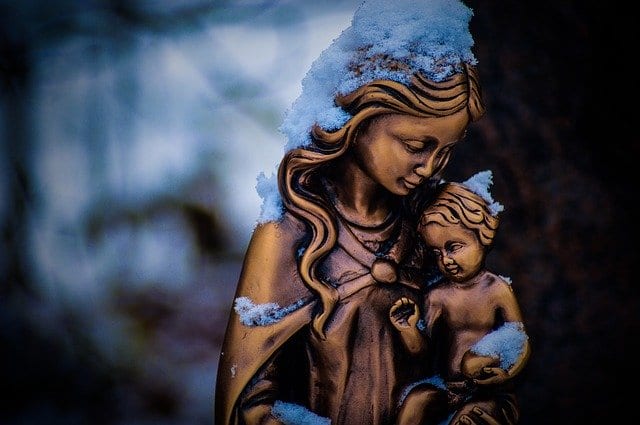
I tried to write an icon the other day.
I used to do it all the time. At least, I don’t have any formal training, but I used to transfer a pattern onto wood and paint the images while meditating and praying. I have quite a cluttered icon corner from all of that. I hadn’t done any iconography or even ordinary painting, for years. But on the feast of Our Lady of Guadalupe, I tried to start on an icon of Our Lady of Perpetual Help.
I hadn’t been at it more than a minute before I started flashing back, and put the icon away.
I shivered for a long time; I got under my weighted blanket and wished she would go away, but of course she didn’t. She is always here.
The Virgin Mary and I have a complicated relationship. I am a product of Apparition Chaser culture; I moved to Steubenville and encountered other, worse forms of spiritual abuse, ones I’ve spoken about and ones I don’t dare speak about yet. I don’t feel safe thinking about her– not all the time, at least. Sometimes she feels so safe and I run to her, but just when I think I’ve gotten over my fear, I get hit with a flashback and wish she’d go away.
I wonder how many people like me there are, all over the world– all throughout history: people who were psychologically scourged with Rosaries, and still bear the scars.
Everyone likes to rag on that sentimental Christmas carol, “Mary, Did You Know?” I don’t like it myself but I also don’t like ragging on sentimental carols. They’re not supposed to be profound. They’re supposed to be sentimental, and as sentiment, they succeed.
Still, sometimes, I wonder.
How much did she know?
Oh, the angel told her that her child would be called great, the Son of God. And the Holy Ghost informed her that all generations would call her blessed. Later on Simeon told her about the sword that would pierce her, and all those things came true. But what else did she know?
She must have known she would be despised. In that moment of her fiat, she surely knew she was risking her life, and was certainly setting herself up to be judged as sinful and dirty by everyone. She was agreeing to become the appearance of sin and scandal– a woman, unwed but with child, and the child not her fiance’s child.
Mary, in her own way, consented to become sin, just as her Son became sin for our sake.
Could she have known, just then, about every woman who would be hurt, with her as an excuse? All the young girls and older women who sinned or even just appeared to sin, or looked like they might want to sin if given half a chance– the women who were too loud, or too ugly, or too inconvenient? Did she see all the women who would be told they were nothing like the Virgin Mary, that they were making the Virgin Mary ashamed; that they needed to shut up, submit, stop crying and be like the Virgin Mary? All the men who would demand women be like the Virgin Mary and abuse anyone they thought didn’t measure up? All the women who would internalize these lessons and go on to abuse other women, in the name of that supremely courageous woman who agreed to allow herself to look sinful for a time, if the Lord willed it?
We’re told the devil took Jesus up to the top of a high mountain and showed him all the kingdoms of the world. “These I will give to you, if you will worship me.” Jesus withstood that temptation, and went on doing the Father’s will. Did anyone ever show Miriam of Nazareth all the kingdoms of the world? The ones who waged war and committed mass murder under banners decorated with her symbols? The soldiers who killed, raped and demolished in her name and her Son’s? The torture and execution committed in her name and His? Did she see churches dedicated to her, where priests abused their flock; where whole congregations joined in traumatizing anyone who was different or weak? Did she see the thousands of millions of people who would be physically, sexually and emotionally tortured, and told it was her will? Did she look out over all that agony, and still tell the angel, “Yes?”
The Gospel tells us that Jesus spent the night before His Passion, suffering a different kind of passion. He went to Gethsemane and prayed alone. He was so terrified that His sweat became drops of blood; He fell on His face and prayed that the cup would pass from Him, “but not my will, but Yours be done.” And the angel came and comforted Him. Tradition says that that angel was Gabriel.
When that same Gabriel was visiting the Mother of God, did she sweat blood?
I hope she didn’t.
I hope she did not know.
I hope she knows now, and suffers with us. But at the moment of her courageous “yes;” at the moment the Holy Ghost revealed the Magnificat to her; at the moment that she beheld the Son of God born from her body in the stable at Bethlehem, I hope she didn’t know.
I hope she did not see me then. But I hope she sees me now.
I believe and profess that she sees me now.
I believe and profess that in every place that her memory was used as an excuse for wrongdoing, she was there, siding with the abused. I believe that the people who were tortured in her name are with her now.
I believe that her Divine Son has already begun casting down the mighty from their thrones and exalting the lowly, though this is taking an awfully long time.
I hope she didn’t know that a time would come when a dowdy and unimportant woman named after her tried to draw her portrait, and started to cry.
But I hope she knows now.
(image via Pixabay)
Steel Magnificat operates almost entirely on tips. To tip the author, visit our donate page.












